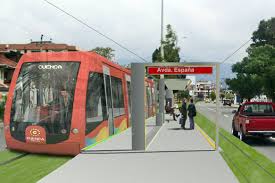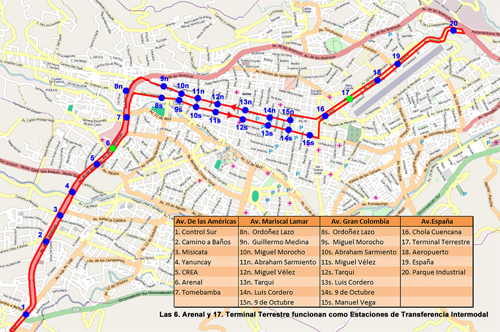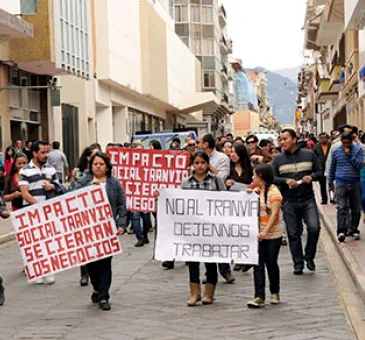Cuenca’s tram project ‘has left the station,’ but opposition to it continues; El Centro property owners, city officials and expats weigh in
By Sylvan Hardy
Although it appears that the final obstacles for Cuenca’s new electric tram system have been overcome, controversy surrounding the project continues.
As one city transportation official put it, “The train has left the station, but there are still some angry people who are not onboard.”
The last major hurdle for the Tranvía de los Cuatros Rios, as it’s officially known, was cleared last month when a team of technical experts from UNESCO found no major problems with the tram’s route through the historic district. The team did recommend a number of steps to protect the city’s heritage and architecture, including conducting an inventory of historic buildings and adding special measures to protect some of them.
Another of the team’s recommendations was to add archaeologists to construction crews as they dig the track foundations in the historic district. The area has been inhabited for thousands of years, the say, and some artifacts will probably be unearthed during track excavation.
Another hurdle was cleared earlier when Cuenca Mayor Marcelo Cabrera, a one-time opponent of the project, said he had changed his mind and now supports it. Cabrera also announced his support for President Rafael Correa, responsible for pushing project funding through the National Assembly, in October at a national meeting of government officials. Cabrera was at odds with Correa for several months after defeating former Mayor Paúl Grandá, a member of Correa’s Alianza Pais party, in the February elections.
THE TRAM PLAN
Planned and designed during Granda administration, the European-style tram system will run along a 21-kilometer route from southwest to northeast Cuenca, from the Control Sur intersection at Av. Las Americas and the Azogues autopista, to the industrial park near Ricaurte. The system is only the third in Latin America, the other two being in Rio de Janeiro and Sao Paulo.
The tram will run through the heart of the historic district, on Calles Gran Colombia, Mariscal La Mar, and Sangurima.
The tram will operate with 14 units of five cars each, each capable of carrying 300 passengers. The system’s 27 stations will be spaced at distances of about 800 meters outside the historic district, and 400 meters within the district. On average, trains will stop at stations every six minutes and travel at speeds of 22 kilometers per hour, compared to average speeds of 8- to 9-kilometer-per-hour for cars and buses on the same route. Fares will be the same as for buses, currently 25 cents, but will probably increase not too long after operations are initiated.
In all, the tram is designed to carry as many as 120,000 passengers a day.
The project contract was awarded to French transportation and tech giant Alstom, which provides both the equipment and on-site project management. The company has relocated about 150 French engineers and their families to Cuenca for the duration of construction.
The majority of funding for the $232 million project comes from the federal government, with the balance provided by the city of Cuenca and two European loans. As of November, about $90 million has been spent on construction, tracks, and rolling stock.
Originally scheduled to be completed in early 2015, the Cuenca transportation office says the system won’t be operational until mid- to late 2016. Cabrera blames some of the delay on poor planning by the Granda administration, but says some of it was necessary to study the project’s impact on the historic district.
THE CONTROVERSY IN EL CENTRO
Although many Cuencanos complain about tram construction, which is causing major traffic congestion on Avs. Las Americas and España, the biggest objection comes from business and property owners along the tram route in the historic district. They admit that they want to stop the project completely.
Business owners say construction will keep customers away and put many of them out of business. When the tram begins operations, they say, it will reduce the number of people on the streets in their neighborhoods because of the elimination of bus routes.
Property owners on the route, many of whom are also business owners, claim that vibrations from the tram will damage the foundations of their properties, a concern that the UNESCO team said is being met by the use of special anti-vibration construction methods and materials.
Owners and residents along the route have held several protest marches to Parque Calderon, and have hung banners along Gran Colombia and La Mar denouncing the project.
In addition to their historic-district objections, project opponents have attacked the tram on other grounds. They have formed the Cuenca Civic Collective and have asked Ecuador’s attorney general to investigate what they say is a mishandling of project funds by public officials. They also claim that the reduction of traffic lanes on major thoroughfares, such as Las Americas and España, will create massive traffic jams.
THE CASE FOR THE TRAM
Tram project manager during the Granda administration, Juan Zea, says the tram is necessary to relieve pressure on overtaxed city streets and to move commuters more efficiently.
“More than 70% of Cuenca’s population depends on public transportation and the current system of buses has not kept up with demand,” he says. “We have 475 buses on the streets and they are not only slow, but are our biggest source of pollution.” Zea said the tram will reduce the number of buses in the historic district by about 20%.
Current project manager and city transportation director, Gerard Fernandez, said a new integrated transport plan is being developed that will tie bus routes into the tram line. “One of the issues with the tram is that it is a single line that doesn’t reach all areas of the city,” he says. “We will overcome this with a system providing bus connections close to tram stations,” he says.
EXPATS WEIGH IN
Cuenca expats who have been following the project have differing takes on the tram.
“I live right on the tram line in El Centro and I can’t wait until it’s finished,” says expat Suzanne Glass. “Now, when I need to get to the airport, I have to stand on the street for 10 or 15 minutes to get a taxi and then there’s the traffic problem. When the train is running, it will take me less than 10 minutes from my door to the airport.”
Another expat, Canadian Paul Espinoza, believes that because similar systems have been successful in Europe, they will be successful in Cuenca as well. “Cuenca is very much like a European city,” he says. “Not only do you have the high population density in the center, but most of the newer neighborhoods outside of the center are also compact and close in. For the same reason the city isn’t good for cars, it’s very good for light rail, which is the case with most European cities.”
Espinoza adds: “I have seen the tram in operation in Bordeaux and Strasbourg and can tell you that it works very well.”
Other expats take a dimmer view. Bill Keyes asks where the riders for the tram will come from. “Proponents say there will be 120,000 passengers a day,” he says. “This is totally unrealistic. Where will the ridership come from? The bus system? Those people won’t change. That means that the ridership will have to come from people abandoning their cars and riding the tram instead. This will not happen,” he says.
Keyes also believes the tram will cause major traffic disruptions, especially in the historic district. “Since the train has the right of way, the timing to close the cross-streets from Unidad National to Huayna Capac will be complicated and will require a very sophisticated computer system to manage it. I don’t see how it will work.”
THE OUTLOOK
Several things are certain. The tram-construction mess will get a lot worse before it gets better. And a final verdict about ridership and the tram’s impact on the historic district will not be rendered until the system is operational. Stay tuned.
For more information about Tranvía Cuatro Rios, watch the YouTube video, click here.

























